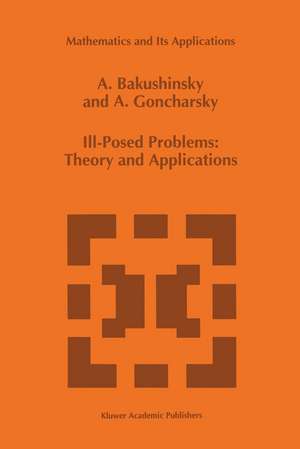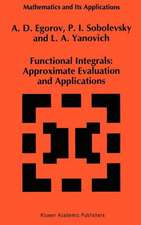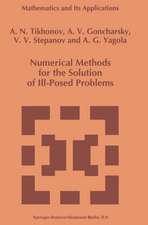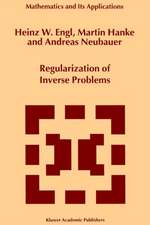Ill-Posed Problems: Theory and Applications: Mathematics and Its Applications, cartea 301
Autor A. Bakushinsky, A. Goncharskyen Limba Engleză Paperback – 9 oct 2012
| Toate formatele și edițiile | Preț | Express |
|---|---|---|
| Paperback (1) | 386.81 lei 43-57 zile | |
| SPRINGER NETHERLANDS – 9 oct 2012 | 386.81 lei 43-57 zile | |
| Hardback (1) | 394.12 lei 43-57 zile | |
| SPRINGER NETHERLANDS – 30 sep 1994 | 394.12 lei 43-57 zile |
Din seria Mathematics and Its Applications
- 9%
 Preț: 627.25 lei
Preț: 627.25 lei - 18%
 Preț: 945.62 lei
Preț: 945.62 lei - 15%
 Preț: 648.42 lei
Preț: 648.42 lei - 15%
 Preț: 651.99 lei
Preț: 651.99 lei - 15%
 Preț: 591.61 lei
Preț: 591.61 lei -
 Preț: 394.29 lei
Preț: 394.29 lei - 18%
 Preț: 950.17 lei
Preț: 950.17 lei - 15%
 Preț: 586.85 lei
Preț: 586.85 lei - 5%
 Preț: 655.17 lei
Preț: 655.17 lei - 15%
 Preț: 658.70 lei
Preț: 658.70 lei - 15%
 Preț: 648.56 lei
Preț: 648.56 lei - 15%
 Preț: 604.84 lei
Preț: 604.84 lei -
 Preț: 394.87 lei
Preț: 394.87 lei - 15%
 Preț: 651.84 lei
Preț: 651.84 lei -
 Preț: 374.76 lei
Preț: 374.76 lei -
 Preț: 394.51 lei
Preț: 394.51 lei - 15%
 Preț: 706.30 lei
Preț: 706.30 lei -
 Preț: 391.02 lei
Preț: 391.02 lei -
 Preț: 389.70 lei
Preț: 389.70 lei - 15%
 Preț: 585.04 lei
Preț: 585.04 lei - 15%
 Preț: 653.98 lei
Preț: 653.98 lei - 15%
 Preț: 587.02 lei
Preț: 587.02 lei - 20%
 Preț: 577.43 lei
Preț: 577.43 lei -
 Preț: 395.47 lei
Preț: 395.47 lei - 15%
 Preț: 601.88 lei
Preț: 601.88 lei - 15%
 Preț: 594.53 lei
Preț: 594.53 lei - 15%
 Preț: 651.84 lei
Preț: 651.84 lei - 15%
 Preț: 649.06 lei
Preț: 649.06 lei -
 Preț: 392.21 lei
Preț: 392.21 lei - 15%
 Preț: 649.06 lei
Preț: 649.06 lei - 15%
 Preț: 643.48 lei
Preț: 643.48 lei -
 Preț: 389.49 lei
Preț: 389.49 lei
Preț: 386.81 lei
Nou
Puncte Express: 580
Preț estimativ în valută:
74.03€ • 76.100$ • 61.11£
74.03€ • 76.100$ • 61.11£
Carte tipărită la comandă
Livrare economică 14-28 aprilie
Preluare comenzi: 021 569.72.76
Specificații
ISBN-13: 9789401044479
ISBN-10: 9401044473
Pagini: 272
Ilustrații: X, 258 p. 8 illus.
Dimensiuni: 160 x 240 x 14 mm
Greutate: 0.39 kg
Ediția:Softcover reprint of the original 1st ed. 1994
Editura: SPRINGER NETHERLANDS
Colecția Springer
Seria Mathematics and Its Applications
Locul publicării:Dordrecht, Netherlands
ISBN-10: 9401044473
Pagini: 272
Ilustrații: X, 258 p. 8 illus.
Dimensiuni: 160 x 240 x 14 mm
Greutate: 0.39 kg
Ediția:Softcover reprint of the original 1st ed. 1994
Editura: SPRINGER NETHERLANDS
Colecția Springer
Seria Mathematics and Its Applications
Locul publicării:Dordrecht, Netherlands
Public țintă
ResearchCuprins
Preface.- 1 General problems of regularizability.- 1.1 Definition of regularizing algorithm (RA).- 1.2 General theorems on regularizability and principles of constructing the regularizing algorithms.- 1.3 Estimates of approximation error in solving the ill-posed problems.- 1.4 Comparison of RA. The concept of optimal algorithm.- 2 Regularizing algorithms on compacta.- 2.1 The normal solvability of operator equations.- 2.2 Theorems on stability of the inverse mappings.- 2.3 Quasisolutions of the ill-posed problems.- 2.4 Properties of ?-quasisolutions on the sets with special structure.- 2.5 Numerical algorithms for approximate solving the ill-posed problem on the sets with special structure.- 3 Tikhonov’s scheme for constructing regularizing algorithms.- 3.1 RA in Tikhonov’s scheme with a priori choice of the regularization parameter.- 3.2 A choice of regularization parameter with the use of the generalized discrepancy.- 3.3 Application of Tikhonov’s scheme to Fredholm integral equations of the first kind.- 3.4 Tikonov’s scheme for nonlinear operator equations.- 3.5 Numerical implementation of Tikhonov’s scheme for solving operator equation.- 4 General technique for constructing linear RA for linear problems in Hilbert space.- 4.1 General scheme for constructing RA for linear problems with completely continuous operator.- 4.2 General case of constructing the approximating families and RA.- 4.3 Error estimates for solutions of the ill-posed problems. The optimal algorithms.- 4.4 Regularization in case of perturbed operator.- 4.5 Construction of linear approximating families and RA in Banach space.- 4.6 Stochastic errors. Approximation and regularization of the solution of linear problems in case of stochastic errors.- 5 Iterative algorithms for solvingnon-linear ill-posed problems with monotonic operators. Principle of iterative regularization.- 5.1 Variational inequalities as a way of formulating non-linear problems.- 5.2 Equivalent transforms of variational inequalities.- 5.3 Browder-Tikhonov approximation for the solutions of variational inequalities.- 5.4 Principle of iterative regularization.- 5.5 Iterative regularization based on the zero-order techniques.- 5.6 Iterative regularization based on the first-order technique (regularized Newton technique).- 5.7 RA for solving variational inequalities.- 5.8 Estimates of convergence rate of the iterative regularizing algorithms.- 6 Applications of the principle of iterative regularization.- 6.1 Algorithms for minimizing convex functionals. Solving the non-linear equations with monotonic operators.- 6.2 Algorithms for minimizing quadratic functionals. Non-linear procedures for solving linear problems.- 6.3 Iterative algorithms for solving general problems of mathematical programming.- 6.4 Algorithms to find the saddle points and equilibrium points in games.- 7 Iterative methods for solving non-linear ill-posed operator equations with non-monotonic operators.- 7.1 Iteratively regularized Gauss - Newton technique for operator equations.- 7.2 The other ways of constructing iterative algorithms for general ill-posed operator equations.- 8 Application of regularizing algorithms to solving practical problems.- 8.1 Inverse problems of image processing.- 8.2 Reconstructive computerized tomography.- 8.3 Computerized tomography of layered objects.- 8.4 Tomographic examination of objects with focused radiation.- 8.5 Seismic tomography in engineering geophysics.- 8.6 Inverse problems of acoustic sounding in wave approximation.- 8.7 Inverse problems of gravimetry.- 8.8 Problems oflinear programming.



























